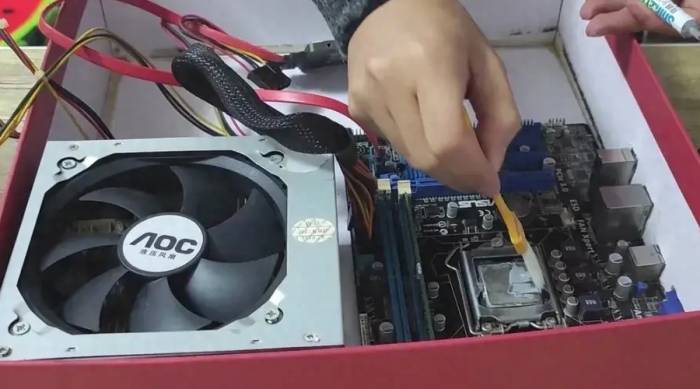tech
What computer accessories can be begged and do not affect performance?
【1】Case
The case is an external object, dispensable, and completely unrelated to performance, but it is also the core representative of aesthetics. Therefore, when you don't care about appearance at all and want to save your budget as much as possible, you can definitely make do with the case. Cases that cost tens, hundreds, or even thousands of dollars are called cases, and a simple box made from a shoebox for DIY can also be called a case.
Retail DIY cases generally have strong compatibility, and the classic ATX structure that has not changed for N years allows it to be compatible with regular motherboards spanning more than a decade or two. The main reasons people change cases are usually because the front panel interface types are too old (for example, no front USB 3.0) or the aesthetics are too low. Of course, low-end cases, due to their thin metal skin, can easily produce resonance and make a lot of noise if too many case fans are installed or if there are mechanical hard drives.
【2】Cooler
The cooler also has nothing to do with the release of essential performance. As long as the CPU is within a safe temperature range (100 degrees Celsius), it will not trigger the throttling mechanism. When the CPU operates, the vast majority of energy is converted into heat and released, so the CPU power consumption we see through software is basically equivalent to the heat output.
Based on this, when we choose a CPU cooler, we are more targeted, such as:(1) CPUs with a typical operating power consumption of less than or equal to 75W can generally opt for entry-level bottom-mounted coolers. On platforms like Taobao, these are priced from a few dollars to around thirty, with copper-core versions being slightly more expensive but offering better heat dissipation capabilities. The original coolers that come with boxed CPUs are also typically of this type.
(2) CPUs with a typical operating power consumption of less than or equal to 100W can consider entry-level dual-heatpipe tower coolers, which range in price from about twenty to fifty yuan. For instance, commonly recommended models include the Red Sea Mini, the Ice Mountain Mini, and the JONSBO CR-1200/E.
(3) CPUs with a typical operating power consumption of less than or equal to 160W may opt for tower coolers with four heatpipes. However, the performance of these four-heatpipe tower coolers can vary greatly (the poor ones might only handle up to 120W, while the good ones could manage up to 200W). When purchasing, it's advisable to consider well-known brands and mainstream models, with prices ranging from 60 to 200 yuan. Standard models are generally under 100 yuan, while those with flashy RGB lighting tend to be more expensive.
(4) CPUs with a typical operating power consumption near 200W can choose tower coolers with six heatpipes. Again, the performance can be highly inconsistent, and some off-brand six-heatpipe coolers might not even outperform four-heatpipe ones. There's no rule that more heatpipes automatically mean better performance; it depends on factors such as the efficiency of the heatpipes, the density of the fins, and the design principles. Mainstream products are priced between 100 and 500 yuan, with RGB-equipped models being slightly more costly.
【3】Power Supply

While ensuring sufficient power, it's possible to "appropriately" reduce the budget by switching to second-tier brands. Since the power supply is crucial for the stable operation of the entire system, it's unwise to cut the budget too much, and it's best to avoid generic power supplies, as malfunctions could potentially affect other components as well.
【4】Motherboard
In principle, as long as the motherboard has adequate CPU power supply design to stably deliver the CPU's performance and its expansion interface versions are compatible with the peripherals, there will be no performance loss. The quality of the motherboard can be quite low as long as it meets these conditions. For example:
If I need a processor like the i3-12100F or i5-12400F, a solid-state drive with a SATA port or M.2 NVMe 3.0, and a graphics card with a PCI-E 3.0/4.0 interface, then any H610 motherboard can almost perfectly accommodate these types of hardware. This is because even the most basic H610 motherboard has at least a 4+1 phase power supply (theoretical power supply capability up to 80W), one M.2 (3.0*4) slot, and a PCI-E 4.0x16 slot directly connected to the CPU. The logic for other motherboards is similar, and the higher the chipset, the less likely there will be issues with expansion interface compatibility.Second-tier brands such as ASRock and Colorful offer motherboards at relatively low prices. When the top-tier brands are only affordable for the most basic models, one can opt for second-tier alternatives.
【5】Memory
To reduce the budget for memory without compromising performance, the first choice is to select inexpensive brands like G.Skill. You can also opt for no-frills or bare-bones memory modules.
【6】SSD
Many solid-state drives on the market, despite being sold under different brands, actually use the same generic solutions. In cases where the solutions are identical, you can choose cheaper brands. Many products using controllers from brands like Phison are essentially the same solution repackaged.